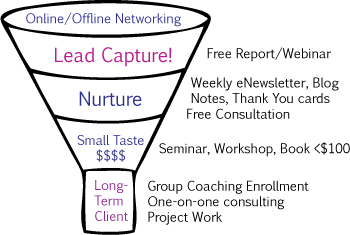How to Attract New Leads and Nurture Them Into Customers
When I meet with a potential client, one of the questions I might ask is, “What does your sales funnel look like?”
The blank stares and nervous coughing I get in response would almost be funny. Except that this is such a crucial piece to seeing any sort of regular business success.
This happened to me at one of my last free consults. I was meeting with Jennifer (not her real name). She came to me frustrated about the lack of response she was getting to her website.
I took a quick look and then said, “Okay, tell me about your sales process — how do you get leads and nurture them into customers?”
She told me she added people to her list by hand as she met them at networking events. But that was it.
There was a sign-up box on her site, but it didn’t say what it was for.
I asked her, “Is this for a newsletter? Or, what type of helpful information are you promising to send?”
She said she didn’t really have a newsletter. But she would send out offers for discounts and sales every once in awhile. Nothing was really planned.
Hmm. I was beginning to see the problem.
And Jennifer’s not the only one operating like this. C’mon. This is an issue that can put a serious crimp in your bank account if you don’t think it through.
Let’s fix that shall we?
First off, a quick explanation: A Sales Funnel looks and functions just like you would expect: wide at the top, narrowing to a small opening at the bottom.
At the top are where your lead attractors live. Things that generate awareness of, and interest in, you and your products (or services). Things like your social media efforts (where you can have additional sales funnels), your free reports, newsletters and other giveaways, any speaking you might do, or articles you might write; and of course, your website.
This is the content of your marketing. (Remember, content is king for a reason!)
NOTE: For every marketing message you send out (to announce a sale or offer a discount), you need to put out at least 5 other non-marketing messages (e.g., sharing helpful or interesting information/content only).
Between the lip of your funnel, and its opening at the bottom (where a lead takes action and becomes a full-fledged customer) there should be some smaller, less risky ways to work with you, or taste your wares. Ways that will nurture someone’s desire for what you’ve got.
The number of levels you have in your funnel will depend on the highest price item or service you offer (the opening at the bottom).
For a small business consultant, this is how that might look:
(This is a very simple example.) In reality, you would have several different offerings in a range of price points so that folks can become your client at a level that’s comfortable for them.
The goal (for you) is to develop a process to nurture the relationship along so that the client buys again and makes a larger purchase when the time is right.
Why You Want to Outline Your Sales Funnel
Knowing exactly what you’re doing when (and why) will help make sure that your marketing happens on purpose, consistently and that things don’t fall through the cracks.
It helps you avoid “Pasta Marketing.”
If you haven’t outlined your sales funnel, you aren’t alone. Most small business owners never do this.
Once Jennifer outlined her sales funnel, she began to see where her marketing was weakest and we were able to create a plan for fixing that.
Outline Your Sales Funnel in Five Steps
It’s not difficult. It just takes time and a little thought.
- Make a list of what you’re doing now. Do a brain dump of every marketing campaign, strategy and tactic that you’re using to promote your business. For each item, make a note next to it of how often you’re doing it, and if you’re spending any money, how much that is.
- Identify how you keep track of leads — all the different ways. Are people able to sign up on your website to receive your newsletter? Do you collect business cards at networking events? Are you connecting with your Facebook fans outside of your page?
- Outline how you nurture those leads. Do you send out an eNewsletter? Handwritten notes? Invite folks to coffee? (Hopefully all of the above.) What else? And how often?
- List all your product and service offerings in order from free to the most expensive.
- Now organize all of this information into a funnel on your paper (yes, you can draw an actual funnel!).
If you’d rather do this electronically, you can download this template (it’s filled out with sample info; just replace what’s there with your own ideas).
It’s Pretty, But What Do I Do With It?
Take a look at it. Where are the holes? What do you need to do more of? Less of? Are you getting a proper return on your marketing investment? Are you attracting enough new leads? Do you need to work on your sales process (the way you “close?”).
Get a marketing professional to take a look at it with you. They’ll likely have some great ideas to help you answer these questions.
Keep this drawing out in plain sight where you can see it every day. This will give your brain time to “stew” on what you’ve created. And it allows space for inspiration to sneak in.
Important: Your sales funnel should be in a constant state of refinement, but don’t change things up too often. Quarterly to bi-annually is good. Marketing, lead tracking, and nurturing folks along takes TIME. And hard work. And if you don’t give something enough time to work, you won’t really know if it IS working.
Lastly, there’s no magic bullet. Sorry. Not even those pre-recorded video series are guaranteed to create your sales for you.
The Sales Funnel is definitely a must-have tool. But you have to work it in order for it to produce tasty results.
Jennifer committed to making changes in her marketing, and is now seeing results as sweet as a proverbial funnel cake.
Once you’ve taken the steps above, you might still have questions. I’d urge you to post them below — it’s probably something that others are wondering, too. I’ll be happy to answer anything, give you ideas, or point you in the right direction. Also — if you’ve got more ideas about how to use the sales funnel, share!











That’s an excellent post Tanya. It has a nice clear layout and is easy to follow. Just a couple of suggestions and questions. If you’re going to put a picture at the top then make sure that the benefits paragraph is still visible above the fold. You could move it up one paragraph to follow your “So Why Raw?” question. A benefit or promise of a benefit near the top of a page is more likely to keep your readers’ interest going. In your post you are referring to “Simply Raw: Reversing Diabetes in 30 Days.” Do you plan to insert a hyperlink to the actual site?Is your blog going to clearly indicate that you are in Australia? If not then you should perhaps add that in your article given that there is also a Pert in Scotland, 1 in Canada, at least 5 in the US. Well done. I’ll be looking forward to seeing the published post.
Hi Sara,This is fascinating. I love your light hearted humour (divorce workshops) and how you’ve interwoven your delight with felt throughout the article. As a description of food stimulates hunger, this article stimulates creativity.Is that your photo wearing the pale blue scarf? It’s beautiful. I think that should be the main image as it conveys more of the deliccy of felt than the dark scarf image..I agree with Elizabeth’s comments on the different sized images. I’d have your pale blue scarf in the centre top and place the lambs and silkworm images somewhere down the page (if you need them at all – you already have other images which haven’t displayed yet).Titles – it’s a choice between clever titles and titles that will help people find your article. This is a learning curve for me. Here are some thoughts:Additional Title SuggestionsFelt | How to Create a Magic FabricFelt | Just Add Wool, Silk, Soapy WaterFelt | Wool, Silk, Soap and PassionFelt | How to Make FeltBest wishes,Julia
Hello Elizabeth,Your article took me straight to your Facebook page to LIKE it. It’s given me inspiration – I’m slow finding fun things to write about serviced offices but put in a lighthearted Valentine’s Day post.I just thought – having an alert for those ”special days” would also help plan ahead for fun posts. Maybe Hallmark puts out a diary of events?As there is a lot to read you could have headings that break the subject into separate pieces so it is easier to follow and digest?Like Lucy I read through your FB page looking for examples of what you were teaching and only found one, so when your article goes live you should maybe have a few in there.Good to have the alert on Coolbean – i just received a Like from them and could not work out who they were except they are based in india. (caution!!)Best wishes,Julia
Hello Gloria, Last year I wrote my homework post for Tea’s review in the TK Alpha Group. In the middle of the post was a colourful little personal story.Tea and my fellow TK colleagues told me to put the personal story first, to lead people in to my article. To begin an article in a personal manner was challenging to me, but now I see how being friendly and open works to break down barriers and interest people. You probably have plenty of personal stories to highlight the benefits of being part of a master mind group?I have a very old copy of Napoleon Hill’s book on my shelf – it’s time to dust it off and apply some of the principles.Re Tea’s advice on using smaller words. I took a writing course recently and the same advice was there – use short, easy words as in spoken dialogue. I felt disappointed that I should drop all those creative colourful words I’ve learned to spell. Writing like we speak is another challenge for me.Enjoyed reading your article and it has me thinking!Julia [Hayes]
I love the visual, makes it easier to remember. I guess I have some work to do.
Great article on developing a sales funnel. Nicely broken down.
Tea,This explanation of the sales funnel is beautifully written. Thank you for breaking it down for us in such a well-laid out fashion!Sherrie